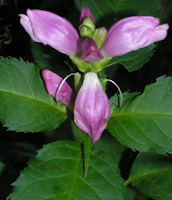This week's bloomlist for Wildflower Island is at the end of the post, and Bonnie's
pictures can be found HERE. Peterson names are used for consistency wherever possible,
and comments and clarifications are welcome in the comments section.
This is the last bloomlist of the season, so we’re saying good-bye to all our floral friends while they get some rest.
So many of the summer stalwarts are now gone for the year – Annual Fleabane, Spotted St. Johnswort, Tuberous Water-lily, Cardinal-flower, and Asiatic Dayflower – and just about gone are the Yellow Wood-sorrel, Herb-Robert and NY Ironweed.
But to see the Masterwort bloom again (Greater or Lesser, don’t know) in The Woods at the bottom of the Rock Steps was really surprising, and there was a beautiful array of White Wood Aster at the gatehouse side of Spruce Oval. The Orpine on the Island is blooming like I’ve never seen it before, and the Bicknell’s Cranesbill is popping up in many places. We’re used to only seeing one of these at a time.
The Partridgeberry was blooming in a few spots today. So unusual to see the two little white flowers when we’ve only be seeing the red berries for weeks. Here’s Bonnie’s picture:
The False Dragonhead (commonly called Obedient flower, but I’m using the Peterson names for consistency) opened for us just in time to say good-bye for the year. Thank you, thank you.
Perhaps my favorite is the White Snakeroot, with so many delicate, pure white blooms contrasting starkly against the dark green leaves when looked at from above. The green in this picture is degrees lighter than the color of the leaves on WFI. Bonnie's picture:
The same white-on-green shows up in Bonnie’s picture of Indian-pipe, against a background of Lycopodium. Reminds me of Christmas.
Notably missing this whole season in The Woods has been the Spiny-leaved Sow-thistle (below left; we never saw any of it) and Pilewort (below right; very few), which leads me to believe Teatown is pruning them out.
Still not sure if we have Swamp or Leafy-bracted Beggar-ticks on the lakeside of the Court Bridge, but this week am leaning towards calling it Swamp because it just doesn’t have the profusion of leaves around the flowerhead that we’ve seen in other seasons. (Same plant as last week, which I’ve changed to Swamp.)
Also defeated by the Goldenrods, which we can’t I.D. exactly. If anyone would like to take that project on, be our guest.
Check out the Pachysandra just as you come into The Woods from the parking lot. Why does it look as if it’s in bud and about to bloom?
No sign of beavers. We are all kind of wondering if they’ve moved on to other waters.
Also defeated by the Goldenrods, which we can’t I.D. exactly. If anyone would like to take that project on, be our guest.
Check out the Pachysandra just as you come into The Woods from the parking lot. Why does it look as if it’s in bud and about to bloom?
No sign of beavers. We are all kind of wondering if they’ve moved on to other waters.
Note: On the bridge to the Island, I forgot to look for the *Straw-colored Flatsedge that might have been across from #5 on today’s list, on the left side of the bridge looking straight down. Oops.
___________________________________________________________________________________



















































